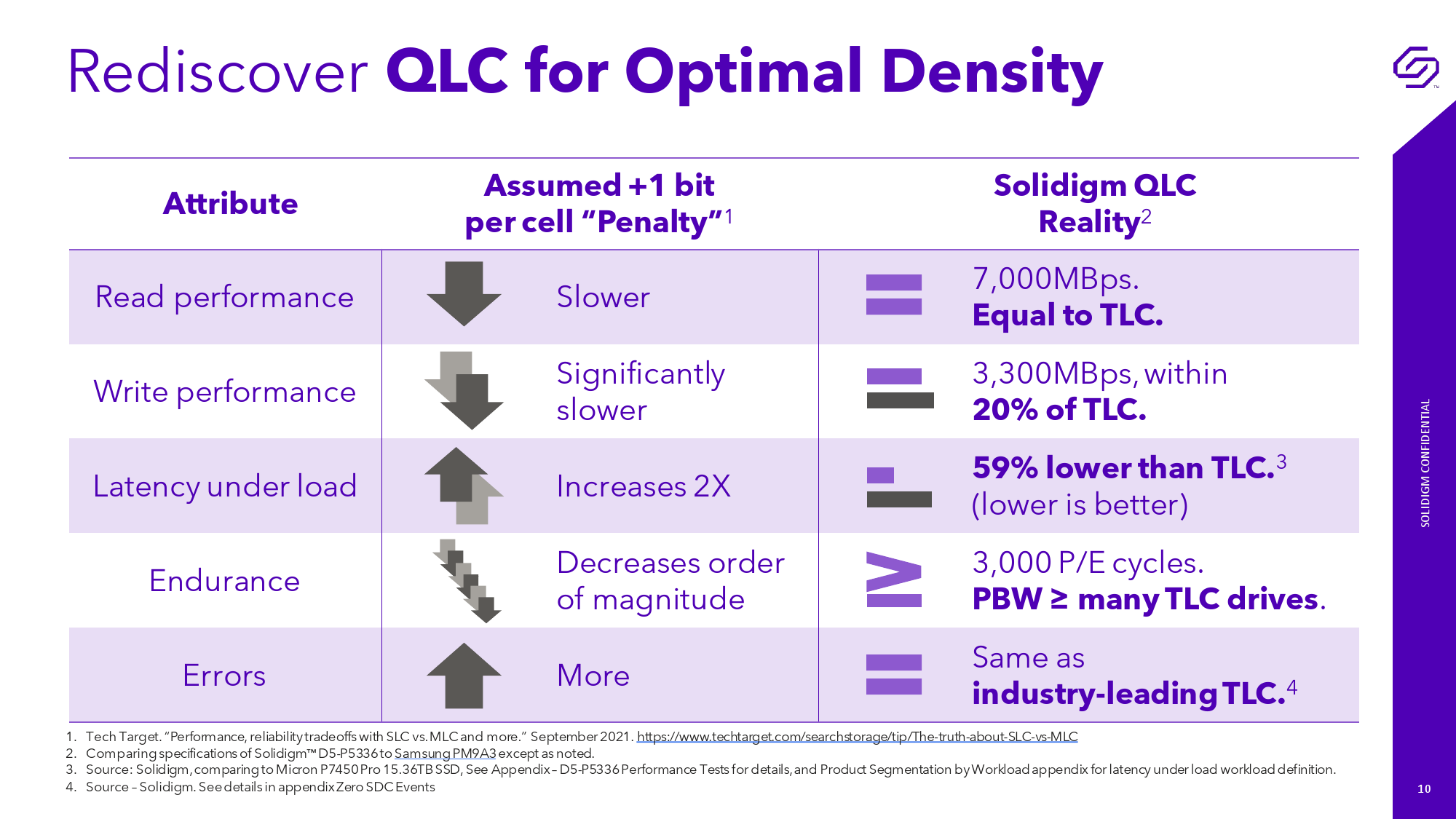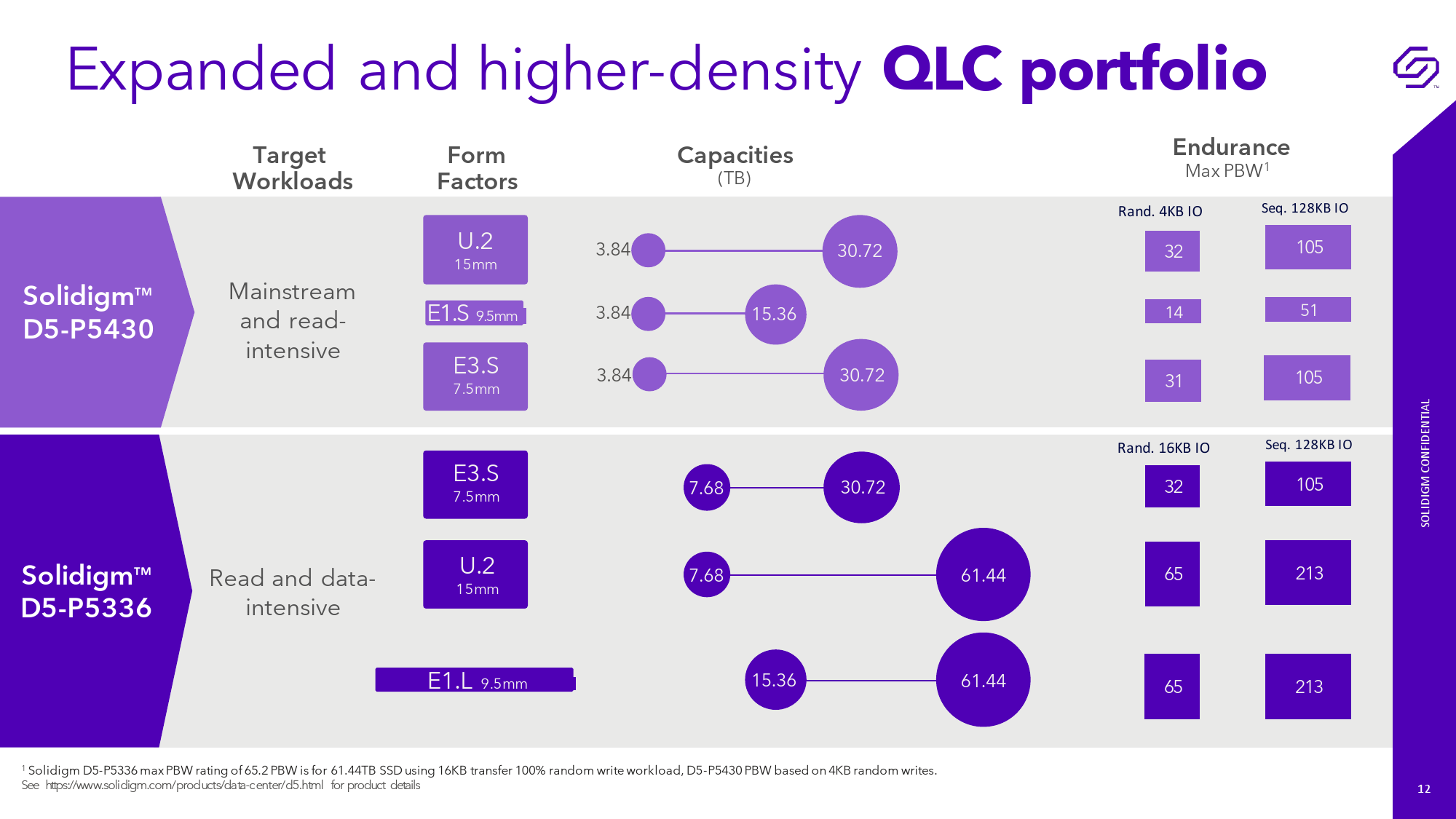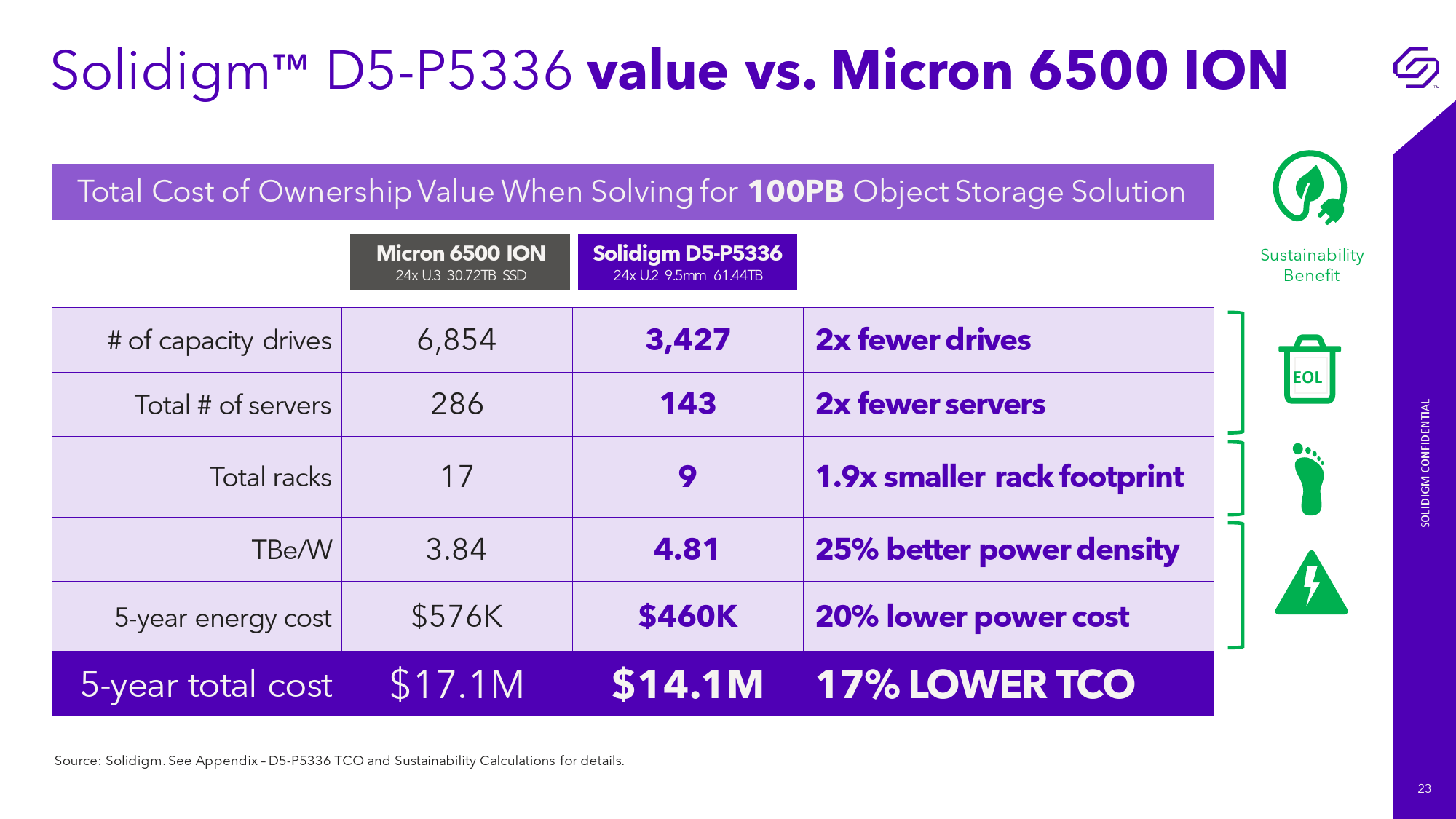Solidigm Launches 61.44TB PCIe SSD: Up to 7,000 MB/s
Solidigm launches the world's highest-capacity SSD with a PCIe interface.

Solidigm has introduced its D5-P5336 drives that boast capacity of up to 61.44TB and feature a PCIe 4.0 x4 interface to enable read speeds of up to 7,000 MB/s. The device is designed to ultra-high-density read-intensive storage applications, such as AI inference on the edge or content delivery. As of now, the D5-P5336 family of solid-state drives that offer extreme capacity and great performance.
"Modern workloads like AI and capabilities like 5G are rapidly reshaping the storage landscape," said Greg Matson, VP of Strategic Planning and Marketing at Solidigm. "Businesses need storage in more places that is inexpensive, able to store massive data sets efficiently and access the data at speed."
Solidigm's D5-P5336 SSD is based on SK Hynix's inexpensive 3D QLC NAND memory as well as a proprietary platform that ensures strong performance and very good endurance in addition to a rather extreme capacity. Solidigm says that its D5-P5336 provides sequential read speed of up to 7,000 MB/s, sequential write speed of up to 3,300 MB/s as well as random read/write speed of up to 1.005 million/38K 4K IOPS, which is rather good given that we are talking about drives that can store up to 61.44TB of data.
"The D5-P5336 delivers on all three — value, density and performance," said Matson. "With 3D QLC, the economics are compelling — imagine storing 6X more data than HDDs and 2X more data than 3D TLC SSDs, all in the same space at 3D TLC speed.
One of the distinctive features of Solidigm's D5-P5336 is their endurance (up to 65 PBW for top capacity drives), which is said to be in line with that of 3D TLC NAND, which is used by competing high-capacity drives that either cannot match D5-P5336 in terms of performance or in terms of capacity.
"For years there has been debate about endurance and reliability of SSDs, QLC in particular, but Solidigm might have ended that debate with the D5-P5336," noted Avery Pham, VP Operations, VAST Data. "Any number of applications will see notable benefits from these drives from AI and machine learning to object storage."
Solidigm will offer its D5-P5336 in three form-factors: U.2/U3 15mm, E3.S 7.5mm, and E1.L 9.5 mm with capacity points ranging from 7.68TB all the way to 61.44TB. Only the U.2/U.3 and E1.L drives will provide the 61.44TB capacity.
Get Tom's Hardware's best news and in-depth reviews, straight to your inbox.
SSD's these large typically feature a SATA interface these days since most of them are designed to substitute for hard drives in applications that do not exactly require extreme performance, but rather need to just increase storage density. But applications like AI deployments on the edge have very specific requirements for storage density (as high as possible) and performance (as fast as possible) and SSD makers have to offer something new here. Apparently, Solidigm just beat its competitors to punch with a 61.44TB drive for these emerging applications.
























Anton Shilov is a contributing writer at Tom’s Hardware. Over the past couple of decades, he has covered everything from CPUs and GPUs to supercomputers and from modern process technologies and latest fab tools to high-tech industry trends.
-
DaveLTX Intel Solidigm conveniently left out Kioxia's 30.72tb SSDs of course.Reply
And it's definitely not because Kioxia can't do QLC but QLC is still riddled with issues. -
Li Ken-un This was earlier than expected. I had thought they’d launch in a few more months. Interestingly, while I can find some D5-P5336 drives listed for sale, none of them are 61.44 TB, the product of interest. For 32 TB-class SSDs, the Micron ones would be far superior with a 4 KiB indirection unit and TLC endurance/performance.Reply
The 30.72 TB one is a mere $1,800 which is quite a drop from the D5-P5316’s $2,400. Assuming $3,600 for the 61.44 TB one when it gets listed, the dollars per TB effectively gets cut in half since last year.
Obviously that is still double the price of consumer SSDs. The bottom of the barrel SSDs could be had for $32/TB now. At the same ratio, a 61.44 TB SSD could be a mere $2,000. One can dream. 😏 -
Darkbreeze Yeah, I'm betting these will cost more than 4000 dollars each. Anything new, or extremely large capacity, commands higher than average price per TB figures simply due to the fact that people and companies will pay for the convenience and need for the large capacity. Dream all you want, it will likely be a while before we see anything that large come in at anything near those prices.Reply
But even so, obviously, these are going to all be going to data centers at immensely large locations anyhow. And maybe, a few very rich fools who don't care about the cost. For the average person, or even very much enthusiast grade users, it will be years and years before any products like this have any relevance for us. Which I know isn't going to come as news to any of you. -
bit_user I think it's cute how they compare against industry-standard TLC drives, while continuing to sell their own TLC drives as a more premium product than their QLC models.Reply -
bit_user Reply
Look at the data transfer rates. It's still not above what PCIe 4.0 can support, so it wouldn't provide any significant benefits. Meanwhile, PCIe 5.0 burns more power, which is a negative for datacenter operators.eye4bear said:Isn't PCIe 5.0 out and if so why did they use 4.0 for these? -
Darkbreeze Reply
I don't know why, other than price, which for an enterprise user or data center probably doesn't even apply in the same way it would for a consumer, you would create a huge, fast and still expensive drive like this and then use QLC rather than TLC. Anybody that's going to pay that kind of money for a single drive will surely expect to get something with a very good endurance rating and clearly we know QLC is going to die faster so the choice is pretty baffling for this product. For consumers looking for the cheapest SSD options they can find, fine, but for applications where up time and longevity are probably far more important to those implementing them, you'd think it would be a no brainer. IMO.bit_user said:I think it's cute how they compare against industry-standard TLC drives, while continuing to sell their own TLC drives as a more premium product than their QLC models. -
bit_user Reply
Size matters. If someone has a large, read-mostly database that they want to keep on SSD, then this could be just the thing. Sure, you can always RAID together multiple smaller drives, but that's both more expensive and more engergy-intensive.Darkbreeze said:I don't know why, other than price, ... you would create a huge, fast and still expensive drive like this and then use QLC rather than TLC.
Also, bigger drives -> higher-density (i.e. more storage per rack unit, meaning you might get by with fewer servers for the same storage).
Finally, consider that AMD's new Bergamo means the standard 2P workhorse server can now have up to 512 vCPUs. Assuming the number of vCPUs per VM stays constant, that means you need more storage (and RAM) to support more tenants per machine.
That said, I have no real cloud computing experience to speak of. These are just some thoughts that came to mind. Maybe some are invalidated for reasons I haven't considered. -
Darkbreeze My question wasn't why you'd want or need a drive this size, but why why you'd use QLC NAND that doesn't have nearly the endurance/longevity as TLC NAND, on a drive that somebody is going to have to pay this much money for. Sure, TLC is more expensive, but if you're already paying that kind of price for a drive anyhow, I doubt anybody is going to balk at paying the difference between QLC and TLC if it means a drive with much better endurance.Reply -
bit_user Reply
Currently, I think the largest TLC drives are only 32 TB? Of course, you'd expect the capacity increase to be < 33%, going from TLC to QLC. And, as I said, there are "read-mostly" applications involving online storage, where write-endurance isn't a major consideration.Darkbreeze said:My question wasn't why you'd want or need a drive this size, but why why you'd use QLC NAND that doesn't have nearly the endurance/longevity as TLC NAND,
Furthermore, they claim to offer very good endurance on these models, with up to 0.58 DWPD on the 64 TB version. Standard 5 year warranty, as well.


